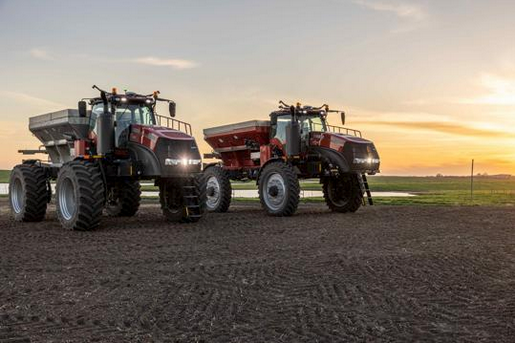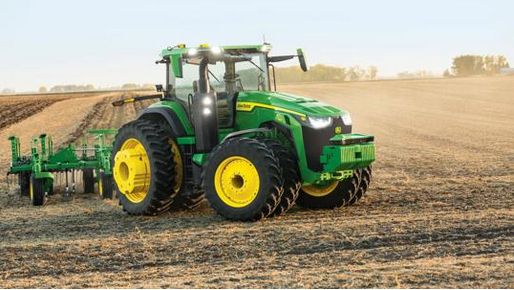
By DAVE BERGMEIER
High Plains Journal
In recent years few innovations have caught the fancy of farmers more than autonomous tractors.
Automation is technologically advanced and a farmer can put a driverless tractor into a field. Specialty crop production has included autonomous orchard harvesters and strawberry harvesters, said Austin Gellings, agriculture services manager for the Association of Equipment Manufacturers, Milwaukee, Wisconsin.
There are some autonomous machines available in the marketplace and experts believe that will continue to accelerate. Experts say operators have to make a decision based on their own situation.
“The agriculture industry is challenged with feeding, clothing and providing fuel for an ever-growing population with less land, less resources and less inputs,” said Christopher Murray, marketing manager at John Deere, Moline, Illinois. “Artificial intelligence has bridged the gap from the days of doing more with more, to getting more with less.”
“These challenges represent opportunities for our customers. At John Deere, we have been focused on integrating technology over the last 30 years into our machines that help us enable farmers to feed, clothe and fuel the world. We see advanced technology growing up in farming operations to meet the ever-growing needs from the world population.”
Early roots
Manufacturers have been incorporating some level of autonomy into machinery dating back to the 1990s with technology such as Autosteer, Gellings said. “Since then we have seen numerous other aspects of farm machinery becoming automated and over the last few years begun to see more and more fully autonomous solutions. However, there are industries like mining that have been operating fully autonomous for quite some time and have a stellar track record with it.”
By deploying an autonomous machine in agriculture, farmers will be able to tend to priority jobs while that machine handles other work the farmer may not have time or available labor to do, Murray said. Autonomous gives farmers back valuable time they can use to spend getting other jobs done or spending time with family and friends.
“It could be the difference between a farmer working through the evening or getting home to enjoy a warm meal with their family,” Murray said. “Deploying an autonomous machine benefits farmers’ bottom line, their livelihoods and the world at large as food demand and hunger increase.”

The drive for using autonomous machines in production agriculture makes sense to Gellings, who says it offers benefits such as taking operators out of harm’s way and with increased efficiency the machines could run for many more hours and one person could monitor several machines at once. Autonomous equipment does take someone who has technical savvy, Gellings said. Anyone who has proficiency in running a farm, incorporating Autosteer and other technologies that require a user interface may already have a level of familiarity.
“From a mechanical maintenance standpoint most aspects of the machine are similar to other conventional machines,” Gellings said.
As farmers update their fleet of equipment, they should consider how the new piece of equipment and the available technology will help increase productivity, performance, yields, sustainability, and quality of life, Murray said.
“At John Deere, our technology stack allows farmers to meet their goals and stretch further into automation with each piece of John Deere equipment,” he said. “Our John Deere dealers have helped farmers realize the value of technology, from the core hardware and software that customer use such as AutoTrac, yield documentation, and John Deere Operations Center, to our most advanced technology available in our automation packages.”
Features familiarity
Many customers choose to order Deere equipment with automation packages that automate many of the functions on the piece of the equipment, Murray said. For example, with Tractor Automation 4.0, the customer gets AutoTrac Turn Automation, AutoPath, AutoTrac Implement Guidance and Machine Sync. The technologies build upon the core technology to make the farmer more productive and increase yields throughout each production step—field preparation, planting, fertilizer application, and during harvest.
“All these available technologies are valuable building blocks to autonomy,” Murray said. “The farmers using our most advanced technologies today will be able to easily make the next step into autonomy once it is available to the industry.”
Case IH, Racine, Wisconsin, has also been a pioneer in autonomous machinery market, and company officials said are continuing to build on a portfolio that meets the needs of growers.
During the recent Farm Progress Show in Boone, Iowa, Case IH and Raven Industries introduced an autonomous spreader—the Case IH Trident 5550 applicator with Raven Autonomy. The technology stack is powered by guidance and steering propulsion control, perception and path planning software developed by Raven.

According to the companies, from a mobile device operators can plan and complete an entire field operation based on mapped field boundaries. Through a series of advanced cameras and radar systems, the Raven Autonomy perception system is constantly sensing a 360-degree environment around the machine for obstacles and motion initiation while operating. With artificial intelligence, Raven’s perception controller processes the continuous stream of images, which interprets and detects obstacles. The remove operator can view the cameras through the mobile device at any time.
Technical reality
While costs may be higher the savings in labor can make autonomous machinery closer to a reality, Gellings said. “This is not just an investment to improve one’s current operation, but it is also a pathway to engage the next generation of farmers who are more interested in technology.”
Gellings said broadband limitations may not be as major of an obstacle for growers but are a key factor in being able to use equipment to its fullest potential both from an autonomy standpoint and being able to fully use other aspects such as data-driven decisions.
While much of the attention has been on large scale tractors there is also a demand for other pieces of autonomous equipment, he said. They include orchard and strawberry harvesters, Gellings said.
John Deere announced the autonomy for tillage at the Consumer Electronics Show this past January.
“Autonomy will open the door for us to continue to innovate more solutions to keep serving our customers in new ways and for the tasks that are most demanding on them,” Murray said. “We will prioritize autonomy for the jobs that occur at the busiest times of the year—like during planting and harvesting—when farmers must contend with limited labor, lots of variables and show windows of times to get things done.”
Farmers, just like any business are always looking to innovate to meet their goals that help increase productivity, performance yields, sustainability, and quality of life, he said. With those goals in mind Deere expects further automation with machinery, further learning about machines, more artificial intelligence, and more autonomy.
“Technology has helped farmers get closer to meeting their goals and will continue to push boundaries in the future,” Murray said.
Republished with permission



